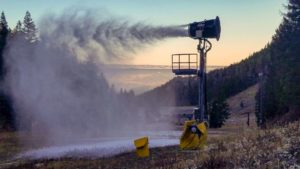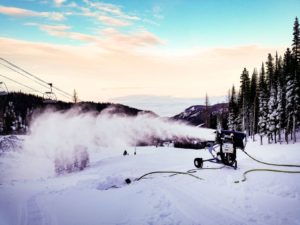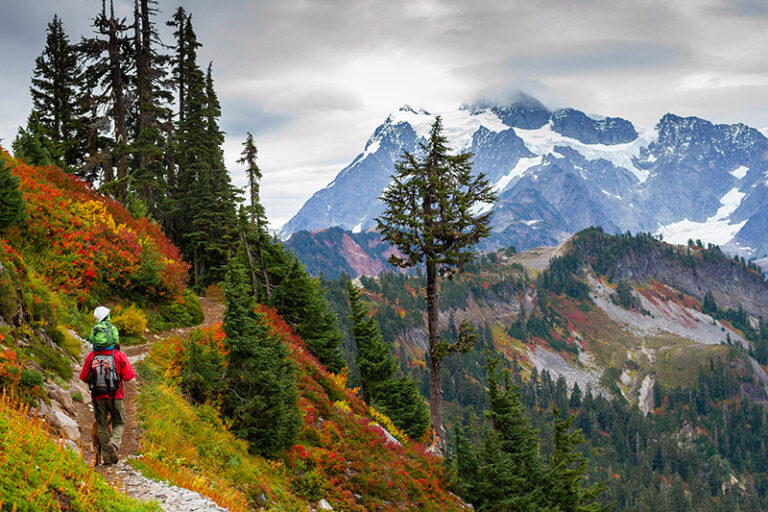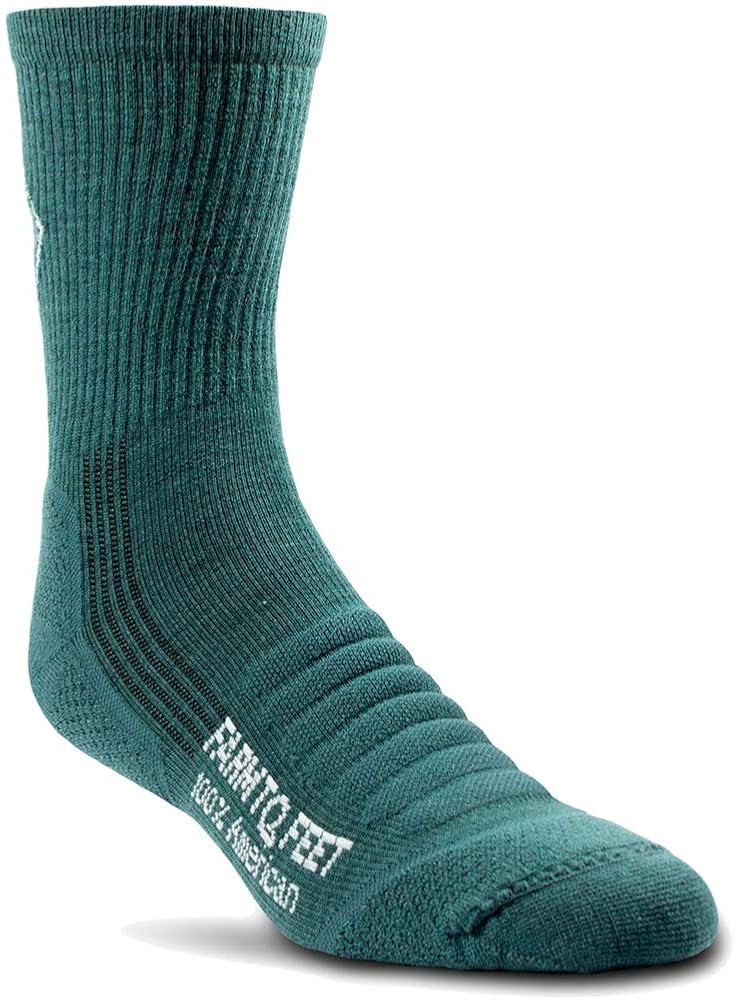By Chris Gabrielli
100 percent coverage, knee-deep powder, and face shots for days—wake up, you’re dreaming. Although almost every ski hill in the Pacific Northwest, and even the interior Northwest, receives more than 200 inches of snow annually, Mother Nature can still be a fickle beast. Seasons start slowly and some years Lady Winter never really shows up. Oh, and there’s also that nagging little thing called climate change, which is quickly diminishing the number of days each year that the mercury falls below freezing.
So what’s a powder hound supposed to do? Enter manmade snow. With its engineered reliability and its harnessing of thermodynamics, snowmaking allows ski hills like Mission Ridge, tucked along the eastern slope of Washington’s Cascade Mountains, to not only weather these storms (or really, the lack thereof), but also dramatically extend their ski season, often for weeks on both ends.
Machine-made snow had its birth in the U.S. on the East Coast in the Catskill Mountains of New York in the 1950s. For decades it was a poetic mix of art and science, and the quality of the finished product was a testament to the skill and experience of the snowmaker. These days systems range from fully automated, computer-controlled masterpieces to relics of the past. But don’t let fully automated trick your senses; as with anything that tries to harness the power of nature, rapidly changing conditions, hiccups in the system, or simply the complexity of the task all keep snowmakers on their toes and hustling to lay down the white stuff.

At Mission Ridge, the first ski hill in the Pacific Northwest to install a snowmaking system back in 1978, more than 40,000 feet of underground pipe connect an 18 million gallon reservoir to more than 20 snow guns. Water rights stipulate that snowmaking cannot occur until 12:01 a.m. on Nov. 1. For Jon Wax, a 21-year veteran of the snowmaking team at Mission Ridge and a recruit to the 2014 Sochi Winter Olympics snow team, this is an inverse Cinderella story. “When the clock strikes midnight on the night of Oct. 31, our team is waiting with hoses laid and guns in place,” says Wax. But instead of leaving a slipper behind, Wax and his team are leaving behind that beautiful frozen water.
The plan is simple enough—start at the top of the mountain where winter comes first and work down, building a continuous 75-acre strip of white from peak to base lodge. Getting the mountain open as early as possible is always the goal, as getting families on the ski hill for the Thanksgiving holiday has become an important part of the ski hill’s vitality.
Snowmaking is a lot like bread making. The ingredients list is almost archaically simple (water, air, and cold), yet the spectrum of finished products is enormously broad; also, just having the right ingredients provides no assurance of a quality final product.
Wax’s favorite temperature? 16 degrees Fahrenheit. “This is the sweet spot for Mission Ridge’s snowmaking system,” he explains. “Running at 100 percent open, the pumps displace 2,000 gallons of water a minute.” At this optimal temperature, minimal snow is lost to evaporation, snow crystals are of the high-quality skiing kind, and temperatures aren’t so cold that system freeze-ups are a problem.

At Mission, the snowmaking crew ensures that each snow gun is tuned to that sweet spot at the intersection of desired snow quality and current environmental conditions. When a gun first starts blowing, Wax stands under the plume of snow, watching crystals bounce off his sleeve. “I may make micro adjustments to the air and water nozzles and shift the gun’s angle to adjust snowflake hang time—a critical component in snowflake formation.”
The snowmaking team works hard to create the best quality snow experience for their guests, laying down dense base snow at first and then finishing with lower-water-content, lighter snow that feels softer under edge. As the snow gets beat up in high trafficked areas, the team will fill patches and move snow from all over the mountain, doing their best to ensure good coverage. By mid-January on a normal year, the snowmaking show at Mission Ridge is largely over. Mother nature takes the baton and provides enough storms to blanket the mountain, rendering the snowmaking system redundant. The work isn’t over yet, though—someone still has to get out there and slay all that powder. //
Snowmaking Stats
Compared to the eastern portion of the country, the West simply gets more snow. This means many Western resorts don’t need snowmaking equipment to blanket their terrain in white. Those that do have snowmaking capacity use it largely to cover high-trafficked areas or augment early season conditions, all in an effort to get you out on the slopes as early as possible. Check out the basic snow stats below to find out how your local ski hill gets its white fluffy stuff.
Mission Ridge: 200 inches of natural snow annually with 75 acres of man-made early season coverage.
Schweitzer: 85 acres of coverage to augment early season skiing, plus 300 inches of au-naturel annually.
Blacktail Mountain Ski Area: No hoses here, just 250 inches annually of pure Mother Nature.
Lookout Pass: Old Man Winter delivers all 400 inches of powder each season, no guns required.
49 Degrees North: Three snow guns with the capacity to cover 13 acres for early season riding, while the 301 inches of annual snowfall takes care of the rest.
Mt. Spokane: 162 inches of that beautiful white stuff and no man-made additions.
Whitefish Mountain Resort: 320 inches of natural snowfall each annum plus equipment to cover lower mountain zones to get you back to the base. //
Chris Gabrielli can be found kayaking Tumwater Canyon, skiing steep couloirs in the Enchantments, or climbing alpine rock in the North Cascades. He wrote about the Mission Ridge expansion in the October/November issue.













